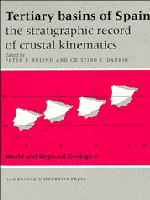Book contents
- Frontmatter
- Contents
- List of contributors
- Preface
- Dedication to Professor Oriol Riba IArderiu
- Memorial, Etienne Moissenet 1941–1994
- PART G GENERAL
- PART E EAST
- PART W WEST
- W1 The Duero Basin: a general overview
- W2 Alpine tectonic framework of south-western Duero basin
- W3 South-western Duero and Ciudad Rodrigo basins: infill and dissection of a Tertiary basin
- W4 Tectono-sedimentary evolution of the Almazán Basin, NE Spain
- W5 Tertiary basins and Alpine tectonics in the Cantabrian Mountains (NW Spain)
- W6 Lacustrine Neogene systems of the Duero Basin: evolution and controls
- W7 North-western Cainozoic record: present knowledge and the correlation problem
- W8 Onshore Cenozoic strike–slip basins in NW Spain
- W9 Tertiary of Central System basins
- PART C CENTRE
- PART S SOUTH
- Index
W4 - Tectono-sedimentary evolution of the Almazán Basin, NE Spain
Published online by Cambridge University Press: 04 August 2010
- Frontmatter
- Contents
- List of contributors
- Preface
- Dedication to Professor Oriol Riba IArderiu
- Memorial, Etienne Moissenet 1941–1994
- PART G GENERAL
- PART E EAST
- PART W WEST
- W1 The Duero Basin: a general overview
- W2 Alpine tectonic framework of south-western Duero basin
- W3 South-western Duero and Ciudad Rodrigo basins: infill and dissection of a Tertiary basin
- W4 Tectono-sedimentary evolution of the Almazán Basin, NE Spain
- W5 Tertiary basins and Alpine tectonics in the Cantabrian Mountains (NW Spain)
- W6 Lacustrine Neogene systems of the Duero Basin: evolution and controls
- W7 North-western Cainozoic record: present knowledge and the correlation problem
- W8 Onshore Cenozoic strike–slip basins in NW Spain
- W9 Tertiary of Central System basins
- PART C CENTRE
- PART S SOUTH
- Index
Summary
Abstract
The Almazán Basin formed between the Iberian Range and the Central System, as a result of NE–SW and N–S Pyrenean compression causing reactivation of NE–SW-and NW–SE-oriented basement faults. The basin covers an area of c. 4200 km2, is up to 55 km wide and 115 km long, and is elongated about a NW–SE axis. In the NE–SW profile, the basin is a half-graben, with up to 2.5 km of sediment deposited along the NE basin margin. In a NW–SE profile the basin deepens to the NW, with maximum basin subsidence (c. 3.5 km) occurring in the environs of Nolay. The NW basin margin is defined by a major dip–slip fault, downthrowing to the SE. Intrabasin faults, located between the towns of Almazan and Burgo de Osma, trend NE–SW, downthrow to the SE and have a wide range of vertical displacements, from c. 20 m up to c. 1.7 km. Sinistral strike–slip movement may have been accommodated on these intrabasin transfer faults. The NE basin margin comprises a SW-propagating thrust fault. The SE margin has low relief and is defined by listric normal faults in parts. In contrast the SW margin is steeper, and controlled by wrench faulting within the Palaeozoic basement and Mesozoic cover sequence.
An informal lithostratigraphy is devised for the Tertiary basinfill, with folded Palaeogene sediments of the NE basin margin assigned to the Henar Group and flat-lying Miocene sediments of the central and southern basin assigned to the Jalon Group.
- Type
- Chapter
- Information
- Tertiary Basins of SpainThe Stratigraphic Record of Crustal Kinematics, pp. 203 - 213Publisher: Cambridge University PressPrint publication year: 1996
- 9
- Cited by

